Do audio interfaces improve sound quality?
You’ve probably heard that you need an audio interface if you’re new to production.
But what goes on inside an audio interface that makes it essential for audio and music production?
Can you get away with not using one?
We’ll answer these questions and more.
Here’s everything you need to know about audio interfaces and sound quality.
Overview
Yes. An audio interface plays a huge role in improving sound quality. As opposed to a computer, audio interfaces have specialized audio converters and higher-quality preamps.
How Does an Audio Interface Improve Sound Quality?
Audio interfaces have higher quality audio converters and preamplifiers than common devices people use to record and listen to audio – computers, tablets, USB mics, etc.
But why are converters and preamps so important in digital music?
To understand why let’s break down the entire recording process.
Sound Card
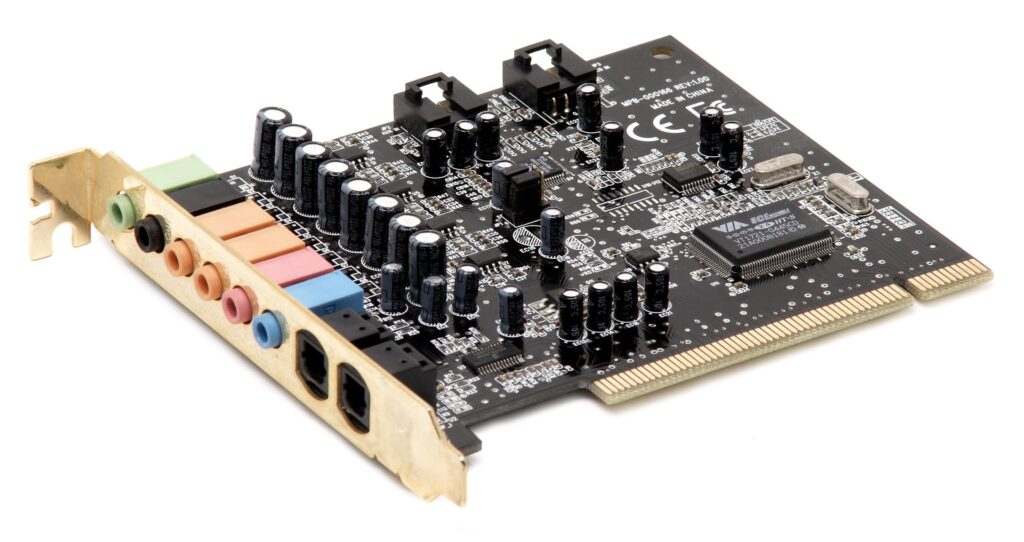
It’s important to note that computers cant process audio signals without a sound card.
A sound card converts audio signals into digital information that your computer can understand.
For example, when you sing into your microphone, it converts the vibrations from your voice into audio waveforms – or audio signals.
From there, your mic sends this audio signal to your sound card.
Ultimately, the type of sound card you use significantly affects sound quality.
Here’s why.
Analog-to-Digital Converter
A sound card converts this audio signal into digital information through an analog-to-digital (A/D) converter.
During this process, the A/D converter samples the audio waveform by taking snapshots of it at regular intervals – the converter records these snapshots as digital 1s and 0s, which is the language your computer speaks.
Digital-to-Analog Converter
From there, your sound card can reproduce the original audio waveform from the digital information on your computer – through a digital-to-analog (D/A) converter.
This part of the conversion lets you hear what’s on your computer through speakers.
Audio Interfaces Have the Best Audio Converters
This example shows how much processing an audio signal goes through during production.
Audio interfaces have higher quality A/D and D/A converters than other devices.
A quality audio interface can help you get recordings that sound true to what you record in your mic.
On the other hand, a low-quality converter – found in most other devices – can negatively alter frequencies and add distortion to your audio.
Preamplifiers
Audio interfaces also have better preamps than a USB mic, for example.
Preamps boost mic level signals to line level – the proper level for recording.
Naturally, mic signals are too low to be useable for recording independently.
They need to go through a preamp, which adds gain to bring them up to line level.
High-quality preamps will add “clean gain” to your signals – resulting in clear and transparent audio.
On the other hand, lower-quality preamps can add distortion to your signal.
Why you Shouldn’t Use a USB Mic for Audio Production
Using a USB mic can be tempting if you’re just getting started – they’re more convenient and generally less expensive than condenser mics.
However, we recommend using a condenser mic with an audio interface for professional sound quality.
While USB mics have built-in audio interfaces, the quality of their converters and preamps don’t come close to the ones in standalone units.
The Problem with Cables and Adapters
As a new music producer, it’s easy to overlook the benefits of having an audio interface if you don’t record audio.
Technically, you can use a 3.5mm cable to connect your studio monitors directly to your computer.
But here’s why not using an audio interface degrades sound quality.
When you use the 3.5mm output on your computer, you’re relying on your computer’s D/A converter to transform digital information into analog signals.
As mentioned before, the D/A converters in computers are lower quality than those in audio interfaces.
As a result, any audio you hear directly from your computer wont accurately represent its true tonal qualities.
This misrepresentation of your sound will lead to poor mixing decisions.
For the best results, we suggest connecting your studio monitors through the balanced outputs on an audio interface.
Two Factors that Influence the Quality of your Audio Converters
Two factors influence how well a device converts audio signals into digital signals: sample rate and bit depth.
An audio interface will typically have a higher sample and bit-depth than other recording devices.
Sample Rate
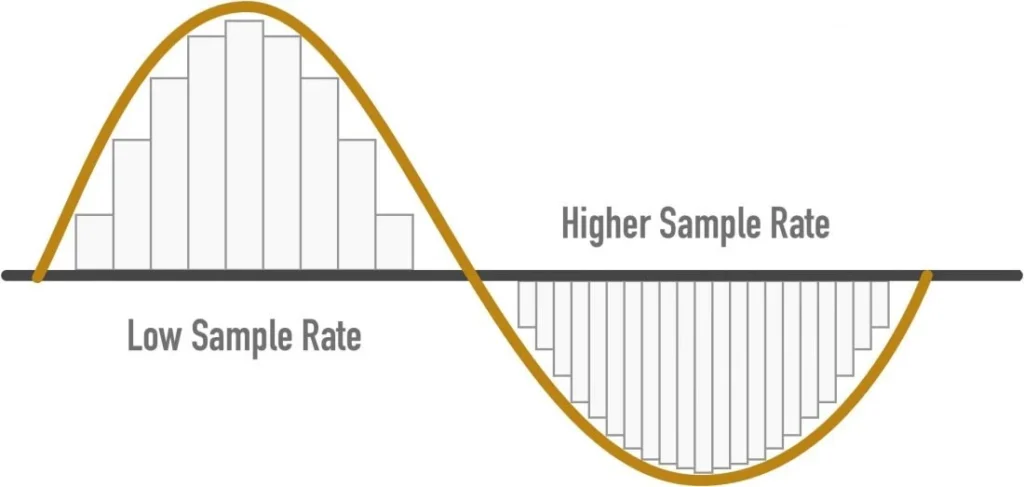
Sound travels in waves.
As mentioned before, a microphone converts incoming vibrations into an electrical analog wave signal.
It sends this signal to your A/D converter, which takes snapshots of its amplitude at regular intervals and records this information digitally.
This process is called sampling.
Therefore, the sample rate of your audio interface is the number of snapshots its A/D converter takes per second.
Typical sample rates are 44.1, 48, 96, and 192kHz.
You can determine the highest frequency your audio interface can record and playback by halving the sample rate.
For example, at 44.1kHz, you can record frequencies up to about 22kHz, which is beyond the human hearing range of 20Hz – 20kHz.
These days, most producers record at least 44.1 and 48kHz.
However, audio interfaces with a max sample rate of 96 and 192kHz are useful for post-production – even though the highest frequencies they can record are way beyond the human hearing range.
Bit Depth
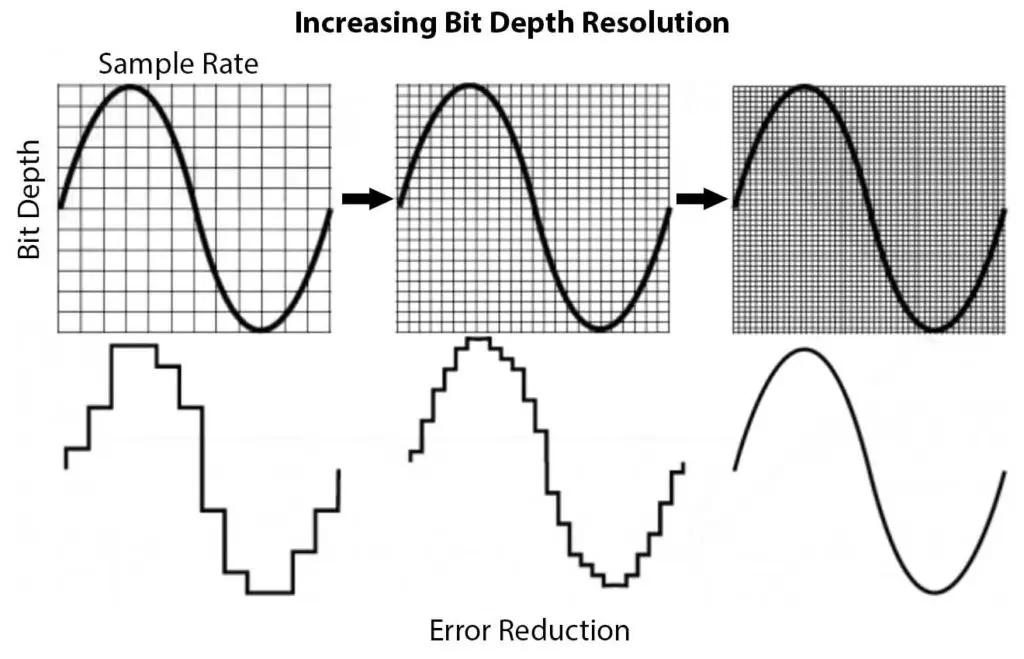
Bit depth is the amount of information taken in each sample.
A higher bit depth allows converters to capture and reproduce data within an audio waveform with greater precision.
This increase in precision means the A/D can capture subtle fluctuations in a waveform more accurately – leading to a closer representation of the original sound.
These days, audio devices with a 24-bit bit depth and a 96 kHz maximum sample rate are considered “high resolution.”
What Determines How Much an Audio Interface Improves Sound Quality?
A $1,000 audio interface will have higher quality preamps and digital audio converters than a $50 interface.
Generally, the more expensive an audio interface is, the better it’ll be.
It’s easy to focus on other recording equipment and cut costs by buying a cheap audio interface.
However, your interface is at the center of the recording process.
Any sound you record into your mic passes through your interface to your computer.
Then it travels back through your interface to your headphones or speakers – going through several conversions along the way.
Even with the best studio monitors and microphones, a low-quality audio interface can negatively affect sound quality.
How to Find an Audio Interface that Improves Sound Quality
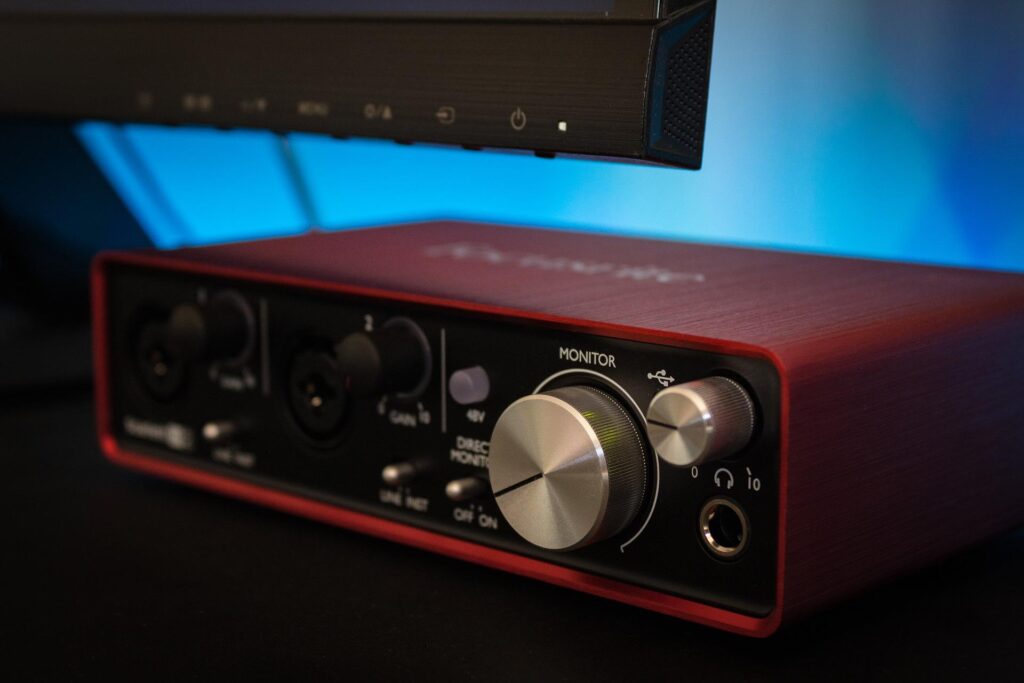
Standard Features to Look For
- Phantom Power (+48v) – used to power condenser microphones
- Direct Monitoring – lets you hear signals directly from your mic to avoid latency when recording
- Hi-Z Input / Instrument Input – used for instruments with low output levels like an electric guitar
- High-Resolution – 24-bit 96 kHz is the standard resolution for a studio-quality audio interface
Input and Output Specs
Dynamic Range
Dynamic range is the difference between the loudest and lowest signal (noise floor) an interface can record.
The larger this number is, the better.
Inputs with a higher dynamic range give you more headroom while recording.
With more headroom, you can record hotter signals – from an electric guitar or loud vocal performance – without adding distortion.
We recommend an interface with at least a 110 dB(A) dynamic range.
Frequency Response
The frequency response for your mic inputs and outputs shows which frequencies your interface can record and playback – typically between 20Hz – 20kHz.
Most audio interfaces have a near-flat frequency response within the human hearing range.
If an interface’s inputs and outputs have flat frequency responses, it can accurately record and reproduce sound without altering its frequencies.
Preamps Specs
Audio interfaces with higher quality preamps help capture audio with accuracy and clarity without unwanted noise.
If you plan on using a dynamic mic, we suggest paying attention to maximum gain and equivalent input noise (EIN).
Dynamic mics produce lower signals than condenser mics and require more gain.
Top-quality preamps can add 60 dB of clean gain to your signals, while lower-end ones tend to max out around 45 dB.
Also, better preamps will have lower EIN near -130 dB(A) – meaning they add very little noise to your signal, even at higher gain levels.
Low-noise preamps with a lot of gain work great with low-sensitivity dynamic mics like the Shure SM7B.
[Here are the 3 audio interfaces with the best preamps]
Onboard Digital Signal Processing (DSP)
Higher-end audio interfaces tend to have built-in DSP effects – compression, EQ, reverb, etc.
You can add these effects to your vocals and instruments while recording without adding latency.
Universal Audio, RME, MOTU, and others offer DSP software.
Best Entry-Level Audio Interfaces
Here are three of the best entry-level.
While there are plenty of other great options, these are some of the best from our experience.
We base our opinion on their recording qualities, preamps, features, and more.
1. Native Instruments Komplete Audio 6 Mk2
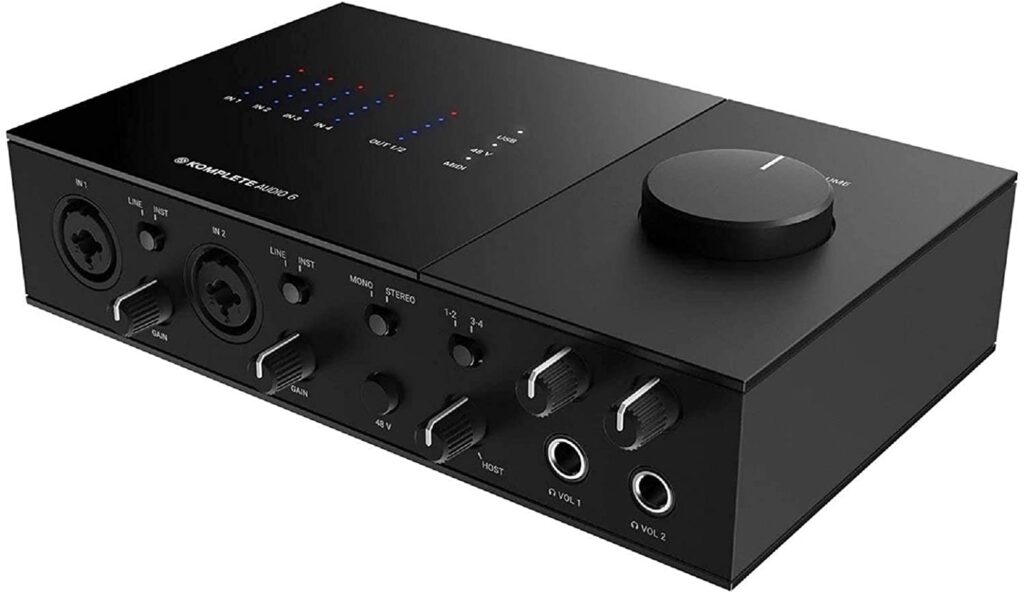
[Check out our review of the Native Instruments Komplete Audio 6 Mk2 here]
2. Motu M2
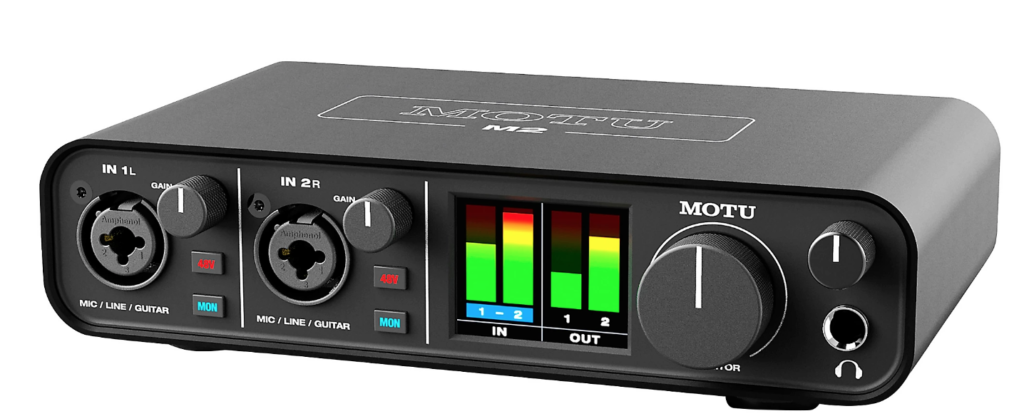
[Here’s our complete review on the Motu M2]
3. Universal Audio Volt 2

[Check out our review of the UA Volt 2 here]
Other Ways to Improve Sound Quality
Audio interfaces help improve sound quality.
But other factors contribute to high-quality vocal recordings – a quality condenser mic, a great pair of studio monitors, headphones, and acoustic treatment.
Record With a High-Quality Condenser Mic
You can improve sound quality by recording with a high-quality condenser mic.
Why not a dynamic mic?
Condenser mics tend to have a wider frequency response and better transient response than dynamic mics- allowing you to record more accurate and clear-sounding vocals.
You can find a quality condenser mic for as low as $300. But more likely closer to $1000 for the best results.
Improve Playback Quality
A great pair of studio monitors and headphones can help you get an accurate representation of your audio.
That way, you can identify what qualities of the recording you need to eliminate, minimize, and emphasize – to optimize your mixes.
Studio Monitors
A quality pair of studio monitors is better for mixing than regular speakers.
Since studio monitors offer a flat frequency response, they can reproduce sound accurately – allowing you to hear the good and bad in your mix.
On the other hand, manufacturers design regular speakers for “listening enjoyment.”
For example, they tend to boost lower frequencies to add bass.
Quality studio monitors typically range from $500 – $1,500.
[Read more on why you need an audio interface for studio monitors here]
Headphones
You’ll also want to reference your mixes on headphones for a great mix.
If you don’t have a fully treated room, headphones can help you identify deficiencies in your mix.
The two types of studio headphones are open-back and closed-back.
Closed-back headphones insulate your ears and minimize external ambient noise for more clarity when mixing.
Open-back headphones produce a more natural sound by letting audio travel in and out more freely.
Each design has different advantages.
Many people reference their mixes using both types.
[Click here to learn when you need a headphone amp with an audio interface]
Acoustic Treatment
You can buy the best microphone, audio interface, and speakers, but the acoustics in your room can still lead to poor sound quality.
To fix this issue, you can add acoustic treatment to your recording and mixing room.
Acoustic treatment is the process of neutralizing echoes and reverberation that naturally occurs in a room.
With a treated room, you can capture cleaner vocals and hear an accurate representation of what you recorded when mixing.
Each room is different.
We suggest running a diagnostic to find problem areas in your room.
Untreated reflections tend to gather in certain spots in a room, which can amplify some frequencies and minimize others.
The goal is to absorb unwanted sound reflections and diffuse others to create a more even frequency distribution.
To properly treat your room for recording and mixing, you’ll need
- Bass Traps – to prevent low-frequency build-up
- Acoustic Panels – absorb and disperse sound from the first reflection point – remove lingering sound from speakers
- Diffusers – scatter sound reflections- help create an even frequency distribution – prevent a dead sounding room
Takeaway: Do Audio Interfaces Improve Sound Quality?
A quality audio interface plays a significant part in improving sound quality.
It has higher quality audio converters and preamps than other recording devices.
You’ll also need a quality mic, studio monitors, headphones, and an acoustic treatment to record clean vocals and hear an accurate representation of what you recorded to get a cleaner mix.
Streaky on Youtube offers a great overview on how audio interfaces affect sound quality. Check out the video below for a summary of the information in this article.








